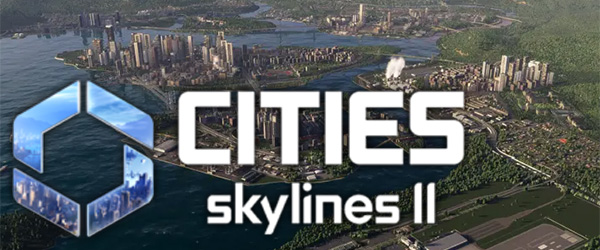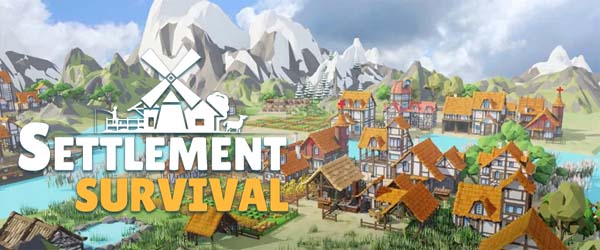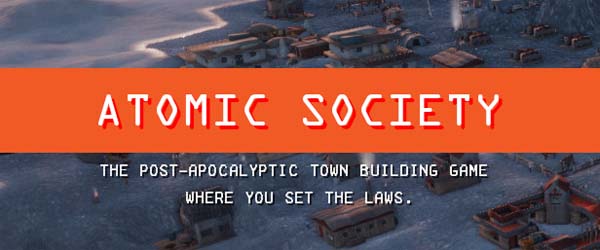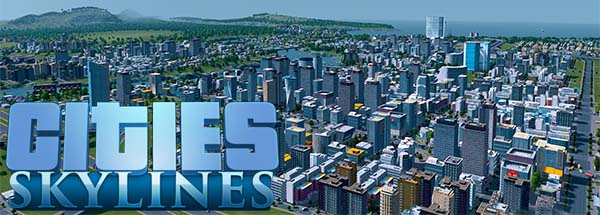
I've been playing Cities: Skylines for almost 10 years. As soon as I started playing it, I recognized it as the definitive city-building game. It blew its contemporaries, such as SimCity (2013) and Cities XL out of the water. It was a smash success that developed a massive following and spawned 11 full expansions, 4 mini-expansions, 21 asset packs, numerous music packs, and thousands of player-created mods and custom assets.
Creating a sequel to a game that is so beloved and content-rich can be challenging or daunting. Sequels to extensively-expanded games, such as any given entry of The Sims, Civilization, Crusader Kings, World of Warcraft, Rock Band, and so forth, run the extreme risk of feeling bland, empty, and incomplete compared to their content-rich and/or mechanically-complex predecessors. This can leave the sequel feeling underwhelming to long-time audiences, who might return to the older game because they crave the extensive, familiar content. The Sims in particular is infamous for stripping out popular expansion content, and then selling that content back to consumers again (and again) as an expansion pack for the sequel. The most notable example is probably that every Sims game has a "Pets" expansion, because EA could never bite the bullet and just put dogs and cats in the vanilla launch of a sequel.
Sequels to expanded games often strip out popular content to re-sell as expansions.
The sequel to Cities: Skylines is a bit of a mixed bag in this regard. On the one hand, yeah, a lot of content from the original game is absent from the sequel, and the options for what players can build can feel a bit sparse. On the other hand, the vanilla release of Cities: Skylines II retains something from almost every one of the original game's expansions. It even includes content and mechanics that were part of some of the smaller content packs and from popular mods.
The vanilla game includes a day/night cycle that was introduced in the original's After Dark expansion. Some of the economic models of the After Dark and Industries expansions have been expanded in scope to apply to the entire game, thus alleviating some of the need for explicit tourism, leisure, or specialized industry districts. It took the winter themes of Snowfall and fleshed it out into a full seasonal cycle. It includes some of the weather and disaster events from Natural Disasters, as well as some of the early-warning and shelter infrastructure. It includes modular upgrades and customizations to certain buildings and infrastructure, as well as large industrial areas, that fills a similar role as the modular areas of Parklife, Industries, Campus, and Airports (though I'll talk more about this mechanic later in the review). It includes pedestrian roads from Plazas & Promenades. It includes eco-friendly variations of utilities that were part of the Green Cities expansion. And of course, it has road-building and transit-planning tools that largely leave Mass Transit in the dust.
It even includes sports parks and parking lots, which were late DLC content released for the original game in the last couple years. And the road-building and traffic-management tools have much of the functionality from the popular "Road Anarcy" and "Network Extension" mods. And that's to say nothing of all the brand new content, mechanics, and more complicated simulation! So even though it is not as full or content-rich as its predecessor with its double-digit expansions (how could it be?!), Cities: Skylines II is still a fully-featured and content-rich city-builder that can be played for many hours before going stale.
Some content and mechanics from almost every CS1 expansion are included in CS2's launch.
But as I said, there is quite a lot of content from the original game that did not make the cut, and which is sorely missed. For one thing, bicycles and bike lanes aren't in the game at launch, which is a kind of baffling decision (considering this game is developed in Scandinavia, where bicycling is huge). There also aren't any walls or fences or quays, and the tool for disabling zoning on either side of a road is strangely absent. So it's back to using pedestrian paths to remove zoning from arterial roads. Zoning is actually quite a bit of a pain in the ass in the sequel, and I am frequently fighting with the road layout, zoning squares, and pedestrian paths to try to get my city to look the way I want.
If you were particularly fond of leveling up and expanding things like industrial parks, nature preserves, amusement parks, universities, and so forth, then you might be disappointed by their absence. In fact, recreation, leisure, and tourism options are very spares in the sequel, as it lacks the tourism and leisure districts of the After Dark expansion. You also won't be building any small fishing villages, since Sunset Harbor is the one expansion that doesn't have anything being carried over into the sequel.
To its credit, the vanilla release of Cities: Skylines II feels more content rich and mechanically-compelling compared to the vanilla release of the original Cities: Skylines. But there's so much absent from the original game, that I un-install the original from my PC with a degree of trepidation.
There is some content from CS1 that is conspicuously absent. [More]
a2c0f15c-0983-4034-a8e5-7561b2c76190|0|.0
Tags:Cities: Skylines, Cities: Skylines 2, Colossal Order, Paradox Interactive, city, city management, city simulation, seasons, industry, parking, tourism, poverty, homelessness, welfare, subsidies, ray-tracing, volumetric lighting, Sedona, Barstow
This week, Colossal Order finally formally announced the anticipated Cities: Skylines 2 and released an official announcement trailer. Unfortunately, the trailer does not have any actual gameplay footage, nor are there any actual in-game screenshots available (that I know of). However, I do want to take some time to go through what is shown in the trailer and make some inferences about what may or may not be in the actual game. Even though the trailer is a pre-rendered cinematic, instead of actual gameplay, we can assume that what is shown in the trailer is intended to represent the actual content of the game -- at least on an abstract level.
First and foremost, here is the trailer itself, in its entirety. I recommend you watch it before reading on.
Cities: Skylines 2 has been formally announced by this trailer.
I will be breaking the trailer down based on 3 criteria. The first is what the narration says, which may provide some hints as to how the game will play. The second is what is actually shown in the trailer. The final category is things that are not included or implied by the trailer.
[More]
cee4240a-11c4-42a4-bfae-e7b10fd50503|0|.0
Tags:Cities: Skylines, Cities: Skylines 2, Colossal Order, Paradox Interactive, city management, trailer, urban decay, waterfront, seasons, parks, traffic, beach, parking, homelessness

As my frequent readers probably know, I am a sucker for city-building and village-building games. I buy a few new ones almost every year, and ever since the release of Banished, the medieval village sim has been all the rage. Though it looks like post-apocalyptic settlement builders are also becoming a hot sub-genre -- probably as a result of the popularity of the settlement-building in Fallout 4. Anyway, last year, Chichian encouraged me to try out a then-Early Access title called Settlement Survival. I was hooked on it for a couple months, and then set it aside with the intent to come back to it later. In the meantime, the game saw its official Steam retail release, which encouraged me to go back and give it a second go (and formal review).
Time to plan
Settlement Survival is one of the more addictive and challenging city-builders that I've played. It features a complicated web of production chains and resources, which can be a real challenge to plan and manage. Trying to unlock and use everything in a single village will take a lot of time, effort, and planning.
Settlement Survival provides a handy-dandy timeline in the top right corner of the screen which shows when all the seasons start and end, and which also shows icons for important upcoming events. Everything from the arrival of a merchant ship, to incoming immigrants, and even disasters or other random events will be forecast a whole year in advance. This gives the player plenty of time to plan ahead, and avoids the problem of the player feeling un-prepared to take advantage of an un-expected boon or to mitigate a disaster.
This timeline is the core gimmick of the game, as it enables long-term planning.
There are also random events that are not forecast on the timeline, and they often require that the player have certain resources or tools on-hand. But these are rarely destructive, so worst case is that you miss out on the opportunity to get some free bonus resources (which you may or may not have needed anyway). Nevertheless, it does put a pressure on the player to build up a surplus stockpile of many goods in case one of these events pops up. Tools and beer being the most common items used for such events, based on my experience.
This timeline helps to create some medium and long-term planning and reward structures that really makes the game crazy addictive. There's the short-term goals for things like building the next building. Then there's the medium-term goals like completing the next harvest season. And then there's the longer-term goals like accumulating goods to trade to an incoming merchant ship, or waiting for the next batch of immigrants to give you a labor surplus that can allow you to go on the next wave of building infrastructure. There's always some milestone right over the horizon, and then another right beyond that, and I find myself playing longer than I had planned, and long after I should have gone to bed, because I want to get to that next harvest, or trade opportunity, or make sure that I get through that next disaster.
This also means that random disasters don't feel as annoying because you have plenty of warning that a disaster is coming, and can prepare accordingly. Further, the disasters themselves rarely kill population directly. Rather, they usually impact your resource-generation for a period of time. So most disasters are mitigated simply by stockpiling the affected resource ahead of time.
There are also random events that do not appear on the timeline.
The timeline also discourages save-scumming. Disasters are forecast a whole in-game year ahead of time, so re-loading to before the disaster would require going back more than a whole year. And that might not even necessarily save you, since I've noticed that the disasters still happen at the same time, even if I go back to a save from before the disaster shows up in the timeline. I'm not sure how long in advance they are generated, but the fact that I know that I can't avoid it by simply reloading and re-rolling a die means that I'm more inclined to batten down the hatches and just roll with whatever happens.
The end result is that the gameplay ends up feeling more organic, and the challenge of surviving and growing your fledgling settlement remains relatively high. When I do save-scum, it's usually to undo some mistake that I made, so that I learn from my mistake, fix it and do better; rather than to outright cheat by undoing some random event that the game threw at me.
[More]

After going back and revisiting Cities Skylines for its Airports expansion and being thoroughly underwhelmed, I decided to did into my Steam backlog for some other lightweight city-builders. Far Road Games' Atomic Society had just left early access in August of 2021, so I went ahead and downloaded it to give it a try. And I was underwhelmed again.
Atomic Society just doesn't have enough content to keep me playing for very long, and the content that it does have is not nearly as engaging as I would like for it to be. It is a town-builder with a post-apocalyptic theme that seems to be heavily inspired by Fallout (possibly by Fallout 4's settlement customization mechanics). In fact, despite being a town-builder, Atomic Society requires the player to create an avatar character whose backstory is that they had emerged from a fallout shelter and is attempting to lead a band of wasteland survivors to a new home. So yeah, it's basically what you get if you imagined Fallout 4's settlement management in the form of a top-down city-builder instead of a first-person shooter. Sounds good on paper, but Atomic Society is far from the best possible take on the subject matter.
Imagine the settlement-building of Fallout 4 ... but without any of the personality.
Wandering alone
New buildings are few and far between. Because this is a post-apocalyptic game with very scarce resources and population, the total number of structures that need to be built is relatively small (though multiple copies of many basic buildings are required, and I'll be talking about that soon). As such, most of the actual game consists of micro-managing the Town Leader. This Town Leader is usually the one who has to build new structures by hand, and who has to go in and salvage materials from ruined structures and vehicles.
In fact, micro-managing this one character is so critical to keeping your town running, that the SPACEBAR (of all buttons!) is assigned the sole function of automatically selecting and centering the camera on the Town Leader. Usually, I would expect the spacebar in a town-building game to do things like pause or unpause the simulation, or to bring up the build menu or some other important management menu. Nope. In Atomic Society, the most important button on the keyboard is for selecting the Town Leader.
The Town Leader will be doing most of the scavenging, building, and repairing.
Micro-managing the Leader wouldn't be so annoying and tedious if the U.X. for managing him were a bit better. For instance, it would be nice to have a widget in the corner of the screen somewhere that shows what the Town Leader is doing at all times, and a small overview of his current inventory. There's not even a mini-map or hotkeys to quickly navigate to important locations on the map. It would also be really nice if the player could queue up actions for the Leader. Without being able to put multiple actions in a queue, I am stuck having to pause the game every few minutes to check on what he is doing and manually assign him to his next task. I'm constantly stopping the game to tell him to run to a salvage site, then back to a stockpile to drop off the materials, then out to build some building, then somewhere else to repair some building before it collapses, then back out to another salvage site.
All this babysitting gets very tedious, very quickly. Worse yet, when it does come time to actually build things, the need to manage the Town Leader can often get in the way and disrupt the flow of settlement-planning.
It doesn't help that path-finding is completely broken. I'll tell him to go to a ruin site or to deposit his inventory in the nearest storehouse, and he'll circumnavigate the entire map to get there instead of taking a direct route. Or he'll pass by right by a storehouse to get to a different one further away. And if I want him to go to a specific nearby storehouse that he refuses to path to on his own, the only alternative for me is to take manual control and walk him across the map myself using the W,A,S,D keys. It's just miserable. [More]

In my last post, I pitched an idea for a new Cities Skylines expansion pack based off of an idea that Colossal Order had posted on its Twitter account. Today, I want to look at a couple of older tweets from Colossal Order that were intended to gauge player interest in some other mechanics and ideas. Those ideas are car wrecks and urban decay.
These concepts aren't as easy to "game-ify" and adapt to Cities Skylines current game mechanics when compared to the season and holiday ideas I pitched in the previous post. Car wrecks and urban decay are both going to require a bit more imagination to come up with ways that they would work within the game.
Colossal Order's Twitter account has apparently been fishing for new content ideas.
Car wrecks and road construction are a disaster!
One of the ideas that Colossal Order proposed in a tweet was the idea of car wrecks being a mechanic in Cities Skylines. Currently, the vehicle and pedestrian pathfinding systems will try to avoid collisions, but it's nowhere near perfect. If you zoom in close enough to any busy intersection and watch it for a while, you'll inevitably see a vehicle phase right through pedestrians or another vehicle. This is especially prominent when vehicles make a left-hand turn.
The game doesn't actually model collisions, however, so no matter how complicated, confusing, or difficult-to-navigate you might make an intersection or highway ramp, no one will ever get hurt or killed in a car wreck. This is a good thing, because if every collision did result in a wreck that would block traffic, traffic would simply never move in the game. I doubt that Colossal Order would ever implement such a feature, since it would probably be considered "in bad taste" by many people. It would also be very difficult to implement from a technical level, as it would require considerable changes to the pathfinding A.I., which would probably weaken the flow of traffic and/or completely tank the performance of the PC. Designing intersections that minimize wrecks would also need a lot more road customization tools!
Cars and pedestrians routinely pass through each other in any busy intersection of the game.
That being said, the idea of delays on the road got me thinking of another potential idea for the game: modeling road construction as a mechanic. I don't think I've ever played a city-building video game in which you had to wait for a road to be constructed before it can be used. Real road construction can often take months or years. Large highway projects can even take decades in real life. In the meantime, the city often has to designate detour routes and close off parts of roads at a time in order to allow access to businesses and homes.
This is a mechanic that seems like it would probably be too complicated to make work reliably, and be fun to play. You wouldn't get immediate feedback on whether your new highway would work, because you'd have to wait minutes or hours of real time (which would translate to weeks or months of simulated game time) for that highway to be constructed before your citizens would start using it. That would be terribly inconvenient.
... [More]
|

| 12 | | | | | | | 60 | | 11 | | | | | | | 55 | | 10 | | | | | | | 50 | | 09 | | | | | | | 45 | | 08 | | | | | | | 40 | | 07 | | | | | | | 35 | | 06 | | | | | | | 30 | | 05 | | | | | | | 25 | | 04 | | | | | | | 20 | | 03 | | | | | | | 15 | | 02 | | | | | | | 10 | | 01 | | | | | | | 05 |
|